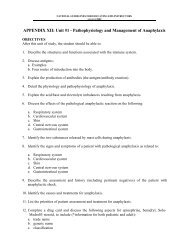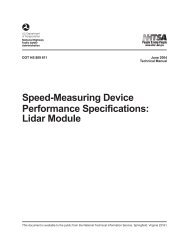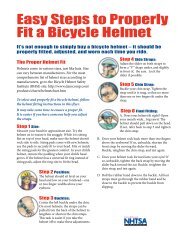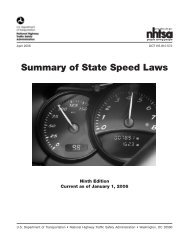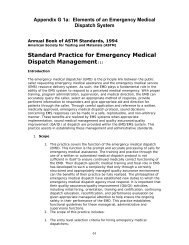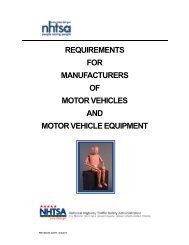The Criminal Justice System: A Guide for Law Enforcement ... - NHTSA
The Criminal Justice System: A Guide for Law Enforcement ... - NHTSA
The Criminal Justice System: A Guide for Law Enforcement ... - NHTSA
Create successful ePaper yourself
Turn your PDF publications into a flip-book with our unique Google optimized e-Paper software.
whatsoever of these concepts, and there<strong>for</strong>e it is imperative to limit scientific jargon as<br />
much as possible.<br />
PRACTICE POINT<br />
USE ANALOGIES<br />
When discussing a scientific principle, immediately follow it up with a simple analogy.<br />
Example:<br />
Scientific principle: Alcohol is eliminated at a fixed or linear rate (“zero order kinetics”),<br />
thus enabling a toxicologist, in many circumstances, to per<strong>for</strong>m retrograde extrapolation<br />
(use a math equation to determine someone’s BAC a short period of time in the past,<br />
measured in hours, not days). However, the elimination rate of other drugs, depending<br />
upon their specific half-life (the period of time it takes the body to get rid of one-half of the<br />
substance) cannot be plotted on a straight line, but rather, is plotted on a curved line over<br />
time (“first order kinetics”). Drug pharmacodynamics—the processes of absorption,<br />
distribution, metabolism, and elimination—do not occur in set chronological fashion, one<br />
after the other, but rather, in combination with each other. Drug effects are also related to<br />
the timeline of drug use, will change over time, and may be further complicated by the<br />
presence of some active metabolites, which themselves will cause certain effects.<br />
Simple analogy: 5 A baseball dropped by a 10-year-old sitting in a tree house, high above<br />
the ground, will fall straight down (alcohol zero order elimination). With practice, the child<br />
might even be able to reasonably predict how long the ball takes to hit the ground<br />
(alcohol retrograde). If that same 10-year-old then drops a maple leaf attached to an<br />
acorn, it should hit the ground at about the same time as the baseball (other drugs with<br />
zero order elimination). However, what would happen if he dropped only the leaf, without<br />
the acorn? It will drop much more slowly—as it is tossed and turned in the breeze—than<br />
the baseball or the leaf with the acorn. <strong>The</strong> leaf’s size also changes during descent as<br />
pieces break off in the wind (changing drug half-life); this also causes its rate of descent<br />
to slow. Eventually the leaf gets to the ground, but not in a straight line nor in a<br />
predictable time frame (drug first order elimination).<br />
CRASH RECONSTRUCTIONISTS<br />
<strong>The</strong> physics and math used by crash reconstructionists can be some of the most<br />
confusing testimony any prosecutor will have to elicit and any juror will have to hear.<br />
Even be<strong>for</strong>e trial, a prosecutor handling a crash case that resulted in injuries or death will<br />
need to meet with the crash reconstructionist to learn what the police report means—Who<br />
was driving? What role did the driver(s) play in the crash? Were the EDRs (“Event Data<br />
Recorders” commonly referred to as “black boxes”) recovered? If yes, what in<strong>for</strong>mation<br />
did they yield? If no, get them to find out what in<strong>for</strong>mation they contain. (This may<br />
require a search warrant.) Were there mechanical problems with any of the involved<br />
vehicles? If yes, should the owner have been aware of these problems? Have there been<br />
any recalls <strong>for</strong> manufacturer’s defects? Was road design/condition a contributing factor?<br />
5 This analogy first appeared in Drug Toxicology <strong>for</strong> Prosecutors: Targeting Hardcore Impaired Drivers,<br />
Dr. Sarah Kerrigan, Ph.D. Published by the American Prosecutors Research Institute, October 2004 and<br />
available <strong>for</strong> downloading at http://www.ndaa-apri.org/publications/apri/traffic_law.html<br />
22



